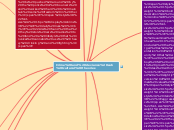Conclude sub-cultural theories with opportunity theory
•Causes of crime are thought to be social and personal factors, but the real and most important cause of it is having the opportunity to commit a crime
Cohen status frustration
Built from Merton’s strain theory but looks at the position of groups within social structures, as opposed to the position of individuals. Focuses on how groups respond to strain.
Cohen (1972)
• He examined the ‘skinhead’ culture and concluded that it had emerged as a symbolic representation of the w/c community that was fading
• Working class boys felt undermined by the growth of the middle class within their society
• They displayed a slightly exaggerated version of traditional w/c male values like aggression and violence as forms of defence and protection
• They had shaved heads, wore heavy boots and baggy trousers (manual worker clothes)
• They were very territorial and racist, particularly towards immigrants because they saw them as a threat
• Skinheads came from a working-class background, and the skinhead culture allowed them to exaggerate their working class masculine backgrounds in order to be distinct and hold on the tradition in the capitalist British society where middle class values were taking over
Marxist sub-cultural theories
Marxists believe crime occurs as a result of the capitalistic system, which is criminogenic (it encourages crime). They think laws are made by the ruling class and favour their interest, and as a result work against the poorer members of society.
Brake (1980)
• Suggested that youth subcultures provide ‘magical’ solutions to its members
• Being part of a subculture provides a sense of safety from the socio-economic problems experienced by w/c youth
• Members have the opportunity to express and experiment with ideas
• However this is all an illusion as they don’t actually make any changes to their lives
Crime and deviance sub cultural theories
What is a subculture?
A subculture is a culture within a culture. It is composed of people who follow a set of values and norms that differ or contradict that of wider society.
Evaluation:
• Offers an explanation for non-utilitarian crime (joy riding, graffiti)
• Relevant to modern society
• Doesn’t include females in his research
• Only looks at working class boys
Factors that lead to status frustration:
• Poor education
• Living in a deprived area
• Cultural, linguistic and material deprivation
• Negative labelling from teachers or others
It is mainly working-class boys who are a part of these subcultures because they are unable to live up to the middle-class goals and aspirations, which leads to a sense of personal failure and inadequacy. Delinquency is their collective response to their low position in the class structure.
Sub-cultural theories in relation to crime and deviance focus on how the difference between sub-cultural values and mainstream values could be an explanation for crime and deviance.
What is a subculture?
A subculture is a culture within a culture. It is composed of people who follow a set of values and norms that differ or contradict that of wider society.
Cohen explored how delinquent gangs attempted to replace society’s norms and values with their own, forming a subculture.
This is done for 2 reasons:
1) For those individuals to gain status because they can use their new norms and values to judge themselves and others.
2) To hit back at society.
Matza also explains why some young people commit crime even though everyone has subterranean values
•Believes that young people go through a period of feeling powerless and alienated (mood of fatalism), but when they act out the subterranean values they feel they matter and like they have an influence on the world (mood of humanism)
•Matza believes that individuals drift out of criminality and assert a mood of humanism through doings things like work and raising a family
Techniques of neutralisation
•Matza outlines 5 techniques of neutralisation in his theory, when delinquents deviate from values they believe in they justify their actions, using techniques of neutralisation, as an exception to the general rule.
1. Denial of the victim
2. Denial of responsibility - When the delinquent defects blame
3. Denial of injury - delinquent defends their actions on the grounds that it did not cause harm to anyone
4. Appeal to higher loyalties -
5. Condemnation of the condemners - Sense of being picked on for something someone else has done but not been punished for
Matza – Drift Theory (Marxist)
•Matza critiques the view that behaviour is determines by one’s subculture
•He believes people are conscious choosing agents
•People drift between law abiding and criminal behaviour depending on their circumstances
Everyone has two sets of values
1.Respectable Values – values such as working hard, obeying laws and respecting people
2.Subterranean Values – which are values such as seeking excitement, being spontaneous and expressing emotions
•Ordinary people will express their subterranean values on appropriate occasions such as nights out
Overall evaluation
Criticisms of sub-cultural theories
•Deterministic – (fullers girls) - assumes everyone is shaped by their subculture
•Only focuses on males
•Questionable whether working class really understand middle class values and aspirations
•Many working-class males conform
•Ignores the role agents of social control
•Does provide an explanation for wealth males that don’t experience strain but still commit crime.
Strengths of sub-cultural theories
•Relevant in contemporary society
•Explains why certain groups of people might commit crime
•Not all the theories victim blame – focus on structural issues that cause crime
•Provides explanations for both utilitarian and non-utilitarian crimes
Howard Parker (1947) – functionalist sub-cultural theorist
•Validates and supports millers study
•Done a participant conversation study on a Liverpool gang
•Found that they didn’t look for trouble but if they are challenged on their ‘toughness’ they would fight
Identified 3 of the focal concerns with in the boys
oSmartness – their ability to pick up girls depended on their looks and wit
oExcitement – they were always on the lookout for fun and a goof night out was a ‘laff’
oAutonomy – they would not be pushed around by the police or bouncers and worked hard to maintain some freedom in their daily lives
•Also found that they stole care radios to fund a lifestyle that involves cannabis use, heavy drinking and fighting
Criticisms of Howard Parker
•The Values can most likely be found across society
•Matza and his notation of drift develops the idea that delinquent behaviours can be linked to mainstream values or ordinary behaviour
Post sub cultural theories
• Theories believe that having an emphasis on class as a defining feature of youth cultures is outdated
Bennet and Khan – Harris 2004
•They note that concepts such as ‘neo-tribes’, ‘scenes’ and ‘post-subcultures’ are used to explain contemporary youth sub culture
Neo-tribes
•They are groups of people who are labelled based on how they dress, what they buy and where they gather
•No official membership- the existence of the tribe depends on participation, if a lot of people dress, buy and gather in places associated with the tribe it thrives
•If majority of the members get new identities and develop new dress, spending and social habits the tribe will disappear.
•Youth culture is now fleeting, fragmented and fluid – it has lost its depth – youth now ‘float’ around making different style changes.
Criticisms
•Neglected more disadvantaged youth when exploring neo-tribes
•Macdonald and Marsh (2005) - those economically excluded are more likely to be involved in ‘leisure careers’ based on long-term ‘street corner society’
Miller – Focal concerns (F-A-T-E-S-T) (Criticism of the functionalist view of C&D)
Miller put forward the idea that there was not one distinct deviant subculture, but rather the working-class culture that promoted a deviant lifestyle. The working-class have always had their culture, traditions and values which are passed on to each generation.
(F-A-T-E-S-T)
• Fate – w/c males have a fatalistic outlook on life. They don’t think much can be done to improve their lives or change their status and their current position (their jobs but also their low status in society) is as good as it’ll get.
• Autonomy – they resent authoritative figures like security and / or police. They don’t want to be told what to do.
• Toughness – ‘men should be men’, w/c males have a certain view of how men should behave: playing sports, drinking, womanising etc.
• Excitement – they constantly search for thrills and pleasure, which can land them in trouble. This relates to their present time orientated mindset and need for immediate gratification.
• Smartness – they have a need to present themselves well ‘smartly’ and be street smart (hustlers, con men).
• Trouble – violence and fights are a normalised, accepted part of life and a way to gain status and reputation.
Cloward & Ohlin (Functionalist)
Similar to Cohen and Merton, Cloward & Ohlin also believed that w/c boys were the most likely to deviate from mainstream values, into subcultural ones. They believed there was grater diversity within criminal subcultures and listed 3 types.
They believed there were 2 opportunity structures in society: a legitimate one and illegitimate one.
They argued that the wc are more susceptible to committing crime because they have limited access to the legitimate opportunity structure. Everyone (regardless of class) is socialised into the value of success but whether the illegitimate or legitimate structure is used depends on socio-economic factors.
The illegitimate opportunity structure has 3 levels:
1. The criminal subculture: an organised criminal subculture found in organised, cohesive w/c communities. There is a hierarchy that provides a role model for the young. Mainly utilitarian crime.
2. Conflict subculture: individuals turn to violence because they don’t have a crime role model to follow.
3. Retreatist subculture: individuals are unsuccessful in both a criminal and violent lifestyle so they turn to drugs / alcohol which are often funded through petty theft or prostitution.
Evaluation
• Provides a more in-depth, diverse perspective on criminal subcultures
• Assumes that common goals are based on material & financial success
• Difficult to prove the existence of the three subcultures
• Ignores middle class subcultures and criminality
• Ignores female members of subcultures









